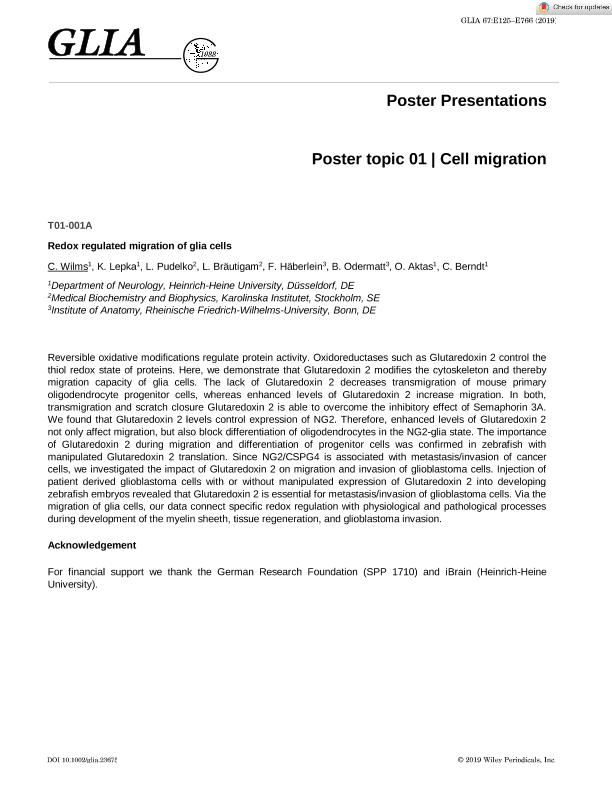Mostrar el registro sencillo del ítem
dc.contributor.author
Monje, Paula

dc.contributor.author
Sant, David
dc.contributor.author
Andersen, Natalia Denise

dc.contributor.author
Camarena, Vladimir
dc.contributor.author
Wang, Gaofeng
dc.date.available
2022-10-27T11:38:18Z
dc.date.issued
2019
dc.identifier.citation
The human Schwann cell transcriptome: species-specificity, long-term stability and changes with differentiation; XIV European Meeting on Glial cells in Health and Disease; Porto; Portugal; 2019; 180-180
dc.identifier.uri
http://hdl.handle.net/11336/175117
dc.description.abstract
Cultured Schwann cells of human origin differ from those isolated from experimental animals in both phenotype and function. However, the basis for this divergence and its significance to potential clinical applications of the primary cells are not fully understood. In this study, we used RNA-seq to comprehensively analyze the human Schwann cell transcriptome and compare it to that of ratcells. We also studied the transcriptomics profiles of human Schwann cells subjected to: (1) the pro-mitogenic effect of growth factors in cells undergoing serial passaging in vitro, and (2) the pro-differentiating action of cAMP, a signal known to promote myelin gene expression in rodent cells.Despite the human Schwann cell transcriptome differedas much as 44% from that of rat Schwann cells established under identical conditions, the human cells maintained their expected Schwann cell identity regardless of sub-culture and the continued influence of mitogenic factors. Strikingly, the transcriptomes of low passage (proliferative) and late passage (senescent) human Schwann cells were essentially undistinguishable with the exception of roughly 100 differentially expressed genes in the senescentpopulations. On the contrary, the human Schwann cell transcriptome was readily and persistently shifted in response to a single treatment with cAMP analogs as highlighted by the >1,300 genes that were upregulated and the >1,700 genes that were downregulated within 1-day post-stimulation. In sum, these results confirmed that human Schwann cellsmaintain their typical gene expression profiles in culture unless challenged with a strong pro-differentiating stimulus. The observed stability of the human Schwann celltranscriptome in the face of expansion and mitogenic stimulation adds a level of safety for theuse of these glial cells in clinical transplantation.
dc.format
application/pdf
dc.language.iso
eng
dc.publisher
Glia
dc.rights
info:eu-repo/semantics/openAccess
dc.rights.uri
https://creativecommons.org/licenses/by-nc-sa/2.5/ar/
dc.subject
HUMAN SCHWANN CELLS
dc.subject
SENESCENCE
dc.subject
RNA-SEQ
dc.subject
CELL DIFFERENTIATION
dc.subject.classification
Otras Ciencias Biológicas

dc.subject.classification
Ciencias Biológicas

dc.subject.classification
CIENCIAS NATURALES Y EXACTAS

dc.title
The human Schwann cell transcriptome: species-specificity, long-term stability and changes with differentiation
dc.type
info:eu-repo/semantics/publishedVersion
dc.type
info:eu-repo/semantics/conferenceObject
dc.type
info:ar-repo/semantics/documento de conferencia
dc.date.updated
2022-03-22T20:17:59Z
dc.journal.pagination
180-180
dc.journal.pais
Portugal

dc.journal.ciudad
Portugal
dc.description.fil
Fil: Monje, Paula. Indiana University; Estados Unidos. University of Miami; Estados Unidos
dc.description.fil
Fil: Sant, David. University of Miami; Estados Unidos
dc.description.fil
Fil: Andersen, Natalia Denise. Consejo Nacional de Investigaciones Científicas y Técnicas. Centro Científico Tecnológico Conicet - Bahía Blanca. Instituto de Investigaciones Bioquímicas de Bahía Blanca. Universidad Nacional del Sur. Instituto de Investigaciones Bioquímicas de Bahía Blanca; Argentina
dc.description.fil
Fil: Camarena, Vladimir. University of Miami; Estados Unidos
dc.description.fil
Fil: Wang, Gaofeng. University of Miami; Estados Unidos
dc.relation.alternativeid
info:eu-repo/semantics/altIdentifier/url/http://www.glia2019.eu/
dc.relation.alternativeid
info:eu-repo/semantics/altIdentifier/url/https://onlinelibrary.wiley.com/toc/10981136/2019/67/S1
dc.relation.alternativeid
info:eu-repo/semantics/altIdentifier/url/https://onlinelibrary.wiley.com/doi/epdf/10.1002/glia.23675
dc.conicet.rol
Autor

dc.conicet.rol
Autor

dc.conicet.rol
Autor

dc.conicet.rol
Autor

dc.conicet.rol
Autor

dc.coverage
Internacional
dc.type.subtype
Congreso
dc.description.nombreEvento
XIV European Meeting on Glial cells in Health and Disease
dc.date.evento
2019-07-10
dc.description.ciudadEvento
Porto
dc.description.paisEvento
Portugal

dc.type.publicacion
Book
dc.description.institucionOrganizadora
European Meeting on Glial Cells in Health and Disease
dc.source.libro
XIV European Meeting on Glia Cells in Health and Disease: Abstracts
dc.date.eventoHasta
2019-07-13
dc.type
Congreso
Archivos asociados
